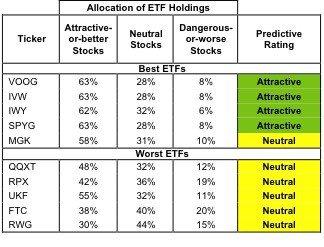The large-cap growth style ranks second out of the twelve fund styles as detailed in my style rankings for ETFs and mutual funds. It gets my Neutral rating, which is based on aggregation of ratings of 25 ETFs and 707 mutual funds in the large-cap growth style as of October 12, 2012. Prior reports on the best & worst ETFs and mutual funds in every sector and style are here.
Figures 1 and 2 show the five best and worst-rated ETFs and mutual funds in the style. Not all large-cap growth style ETFs and mutual funds are created the same. The number of holdings varies widely (from 12 to 572), which creates drastically different investment implications and ratings. The best ETFs and mutual funds allocate more value to Attractive-or-better-rated stocks than the worst, which allocate too much value to Neutral-or-worse-rated stocks.
To identify the best and avoid the worst ETFs and mutual funds within the large-cap growth style, investors need a predictive rating based on (1) stocks ratings of the holdings and (2) the all-in expenses of each ETF and mutual fund. Investors need not rely on backward-looking ratings. My fund rating methodology is detailed here.
Investors seeking exposure to the large-cap growth style should buy one of the Attractive-or-better rated ETFs or mutual funds from Figures 1 and 2.
Get my ratings on all ETFs and mutual funds in this style on my free mutual fund and ETF screener.
Figure 1: ETFs with the Best & Worst Ratings – Top 5
* Best ETFs exclude ETFs with NAV’s less than $100 million.
Sources: New Constructs, LLC and company filings
Figure 2: Mutual Funds with the Best & Worst Ratings – Top 5
* Best mutual funds exclude funds with NAVs less than $100 million.
Sources: New Constructs, LLC and company filings
Vanguard S&P 500 Growth ETF VOOG is my top-rated large-cap growth ETF and FundVantage Trust: Polen Growth Fund POLIX is my top-rated large-cap growth mutual fund. Both earn my Attractive rating.
Columbia Large-Cap Growth Equity Strategy Fund RWG is my worst-rated large-cap growth ETF and earns my Neutral rating. Quaker Investment Trust: Quaker Strategic Growth Fund QUAGX is my worst-rated large-cap growth mutual fund and earns my Dangerous rating.
Figure 3 shows that 299 out of the 992 stocks (over 46% of the total net assets) held by large-cap growth ETFs and mutual funds get an Attractive-or-better rating. However, only four out of 25 large-cap growth ETFs (less than 12% of total net assets) and 19 out of 707 large-cap growth mutual funds (less than 1% of total net assets) get an Attractive-or-better rating.
The takeaways are/is: mutual fund managers allocate too much capital to low-quality stocks and large-cap growth ETFs hold poor quality stocks.
Figure 3: Large-cap Growth Style Landscape For ETFs, Mutual Funds & Stocks
As detailed in “Cheap Funds Dupe Investors”, the fund industry offers many cheap funds but very few funds with high-quality stocks, or with what I call good portfolio management.
Investors need to tread carefully when considering large-cap growth ETFs and mutual funds, as only four ETFs and 19 mutual funds in the large-cap growth style allocate enough value to Attractive-or-better-rated stocks to earn an Attractive rating.
Abbott Laboratories ABT is one of my favorite stocks held by large-cap growth ETFs and mutual funds and earns my Very Attractive rating. ABT has proven itself to be a reliable and effective steward of capital, earning an ROIC consistently above 13% for the last 13 years while operating in the dynamic pharmaceuticals industry. Despite this strong history, the market is pricing ABT at ~$69.42, which implies that ABT’s cash flows will decline by 11% permanently. With these low expectations, ABT is well positioned to outperform.
Equinix Inc. EQIX is one of my least favorite stocks held by large-cap growth ETFs and mutual funds and earns my Very Dangerous rating. EQIX is a value destroyer, generating negative economic earnings every year for the last 12 years. On top of this history of poor earnings is a valuation (~$188.67/share) that requires EQIX to grow its profits annually by 12% for the next 26 years. Such a high performance hurdle with a history of poor results makes EQIX a stock to avoid.
Figures 4 and 5 show the rating landscape of all large-cap growth ETFs and mutual funds.
Our style rankings for ETFs and mutual funds report ranks all styles and highlights those that offer the best investments.
Figure 4: Separating the Best ETFs From the Worst Funds
Figure 5: Separating the Best Mutual Funds From the Worst Funds
Review my full list of ratings and rankings along with reports on all 25 ETFs and 707 mutual funds in the large-cap growth style.
Disclosure: I receive no compensation to write about any specific stock, sector, style or theme.
Edge Rankings
Price Trend
© 2025 Benzinga.com. Benzinga does not provide investment advice. All rights reserved.
Trade confidently with insights and alerts from analyst ratings, free reports and breaking news that affects the stocks you care about.




